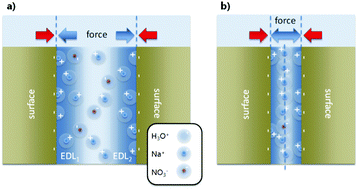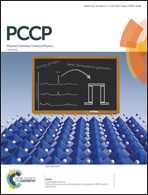Collective dehydration of ions in nano-pores†
Abstract
Hydrated ions can enter nanometre pores that are smaller than the hydrated ion diameter – the associated dehydration mechanism is still poorly understood. Using an adjustable model slit pore between negatively charged mica surfaces, we have followed the dehydration of highly confined Na+ counter-ions as a function of salt concentration. We applied external load to the slit pore and resolved the induced sub-nanometre film-thickness transitions, in order to gain information about any structural elements present. At a given concentration, the pull-off force required to reopen the collapsed pore is a sensitive measure for the final hydration state of the confined ions at the interface. Remarkably, we observe a two-step evolution of pull-off force, suggesting two-stage collective ion dehydration. There is a notable coincidence between this process and the occurrence of hydrated-ion layering, as previously observed for K+ ions, suggesting that a similar mechanism is at work. The gained insights into equilibrium collective ion dehydration in nano pores add to our fundamental understanding of confined electrical double layers. This may be ultimately translated into design criteria for future nano-porous electrode materials and nanofiltration membranes used for water treatment, or electrical-double-layer capacitors.



 Please wait while we load your content...
Please wait while we load your content...